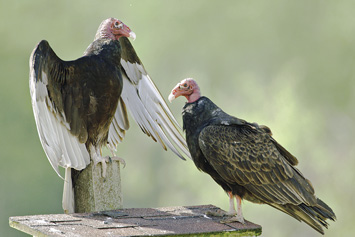 By DAN ZARLENGA
By DAN ZARLENGA
Missouri Department of Conservation
A lot of people consider the month of February to be the dead of winter. And while dead may not sound to good to us, it does sound pretty appealing to some animals. For example, the turkey vulture. It survives on death.
Most people know that turkey vultures are one of Missouri’s premier scavengers. They can be found throughout the entire state, seeking out carrion for food. Turkey vultures are very large birds — up to 27 inches from beak to tail — and have black plumage. What really stands out, though, are their distinctively red heads. Small, bare, and wrinkled, these unattractive faces are not likely to win any beauty contests.
What these birds lack in beauty on the ground, they can make up for in grace on the wing. When soaring high on thermals, turkey vultures hold their impressive 70 inch wingspans in a V position, often lilting from side to side as they go. One might even mistake the vulture for hawk.
CIRCLING
Turkey vultures are often seen circling in the air. They fly in a spiral pattern by making use of warm air currents which rise in a spiral as well, enabling the vulture to effortlessly hitch a ride. In fact, a turkey vulture barely uses any more energy flying in this way than it does standing motionless on the ground. The method works so well, turkey vultures use it to spiral down to their roosts at the end of the day as well. Their movements, if not their features, can indeed be beautiful.
In order to find a meal, turkey vultures rely on their incredible senses. Their sense of smell far exceeds that of a canine, allowing them to zero in on a dead animal from the air, even if that animal is covered by debris. But that’s not to sell short their amazing sense of sight. The eagle-eyed turkey vulture can spot a potential meal from as much as a mile away!
FASCINATING ADAPTIONS
As a result of feeding on dead things, these birds have some fascinating adaptations. Those featherless heads for example are no accident. Vultures feed by submerging the entire heads into the carcass. Their bald heads keep blood and unsavory substances from sticking to their feathers, where they could otherwise attract flies and harbor infectious bacteria. Even so, a turkey vulture’s stomach contains microorganisms that enable it to consume dangerous pathogens safely without getting sick.
Speaking of infections, vultures often protect mammals from diseases like rabies. Such viruses don’t affect the carrion-eating birds, and when they consume an infected animal’s meat, the rabies virus is prevented from spreading to vulnerable mammals. It’s just one reason these scavengers play such an important role in the environment.
SELF-DEFENSE
One of their most bizarre habits has to do with self-defense. When a turkey vulture is threatened, it will sometimes vomit at its aggressor. Considering how unsavory a vulture’s food is going in, one can only imagine how terrible it must be going out! Beyond that, the potent acid contained in their stomachs can cause significant burns to a would be attacker.
Ugly, unusual, and in many ways, unappealing. These words can indeed describe turkey vultures, the kings of carrion. But then again, so do words like unique, amazing, and indispensable. Their appetite for the dead is essential to the living.


